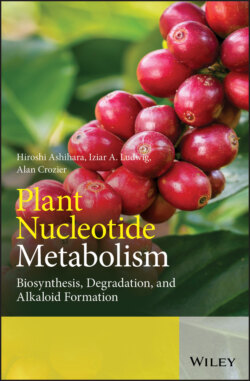Читать книгу Plant Nucleotide Metabolism - Hiroshi Ashihara - Страница 46
3.7 Supply of 5-Phosphoribosyl-1-Pyrophosphate
ОглавлениеPRPP is an essential substrate for the biosynthesis of nucleotides. In the case of purine nucleotide synthesis, the first step is phosphoribosylamine (PRA) formation from PRPP (Figure 3.1a). In pyridine and pyridine nucleotide biosynthesis, PRPP is used in intermediate steps, namely the formation of nicotinate mononucleotide (NaMN) (step 3 in Figure 3.1b) and OMP (step 4 in Figure 3.1b). In addition to its involvement in de novo nucleotide biosynthesis, PRPP also acts as a substrate in several pathways including salvage biosynthesis of purine, pyrimidine, and pyridine nucleotides as well as tryptophan and histidine biosynthesis (Becker 2001). The enzyme reactions which utilize PRPP as a substrate are summarized in Table 3.2.
PRPP is synthesized from ribose-5-phosphate and ATP by PRPP synthetase (EC 2.7.6.1, ATP: D-ribose-5-phosphate diphosphotransferase). In plants, ribose-5-phosphate is an intermediate in the photosynthetic reductive pentose phosphate cycle (Calvin–Benson–Bassham cycle), as well as the oxidative pentose phosphate pathway. The reductive cycle is the major CO2 fixation pathway. CO2, molecule at a time, is added to the acceptor molecule ribulose-1,5-bisphosphate (RuBP) generating two molecules of 3-phospho-glycerate (Figure 3.5). The oxidative pentose phosphate pathway is an alternative route for oxidizing glucose. As a result, the pentose phosphate pathway is a major source of reducing equivalents for biosynthesis reactions. The pentose phosphate pathway is important for the conversion of hexoses to pentoses such as ribose-5-phosphate (Figure 3.6). Therefore, ribose-5-phosphate is generated both in chloroplasts and the cytosol of plant cells.
Table 3.2 5-Phosphoribosyl-1-pyrophosphate PRPP-utilizing enzymes in plants.
| Enzyme | EC | Reaction |
| Purine nucleotide biosynthesis | ||
| Phosphoribosylamine synthetase | 2.4.2.14 | Glutamine + PRPP → PRA + PPi |
| Adenine phosphoribosyltransferase | 2.4.2.7 | A + PRPP → AMP + PPi |
| Hypoxanthine-Guanine phosphoribosyltransferase | 2.4.2.8 | HX + PRPP → IMP + PPi |
| G + PRPP → GMP + PPi | ||
| Xanthine phosphoribosyltransferase | 2.2.2.22 | X + PRPP → XMP + PPi |
| Pyrimidine nucleotide biosynthesis | ||
| Orotate phosphoribosyltransferase | 2.4.2.10 | O + PRPP → OMP + PPi |
| Uracil phosphoribosyltransferase | 2.4.2.9 | U + PRPP → UMP + PPi |
| Pyridine nucleotide biosynthesis | ||
| Quinolinate phosphoribosyltransferase | 2.4.2.19 | Q + PRPP → NaMN + PPi + CO2 |
| Nicotinate phosphoribosyltransferase | 2.4.2.11 | Na + PRPP → NaMN + PPi |
| Nicotinamide phosphoribosyltransferasea) | 2.4.2.12 | N + PRPP → NMN + PPi |
| Tryptophan biosynthesis | ||
| Anthranilate phosphoribosyltransferase | 2.4.2.18 | Anthranilate + PRPP → Phosphoribosylanthranilate + PPi |
| Histidine biosynthesis | ||
| ATP phosphoribosyltransferase | 2.4.2.17 | ATP + PRPP → Phosphoribosyl-ATP + PPi |
a) This activity is usually not detected in plants.
Figure 3.5 Photosynthetic Calvin–Benson–Bassham cycle. (1) Ribulose bisphosphate carboxylase/oxygenase; (2) phosphoglycerate kinase; (3) glyceraldehyde-3-phosphate dehydrogenase; (4) aldolase; (5) fructose-bisphosphatase; (6) transketolase; (7) aldolase; (8) sedoheptulose diphosphatase; (9) transketolase; (10) erythrose-4-phosphate isomerase; (11) phosphoribulokinase.
Figure 3.6 Oxidative pentose phosphate pathway. (1) Glucose-6-phosphate dehydrogenase; (2) 6-phosphogluconolactonase; (3) 6-phosphogluconate dehydrogenase (decarboxylating); (4) ribose-5-phosphate isomerase; (5) ribulose-5-phosphate 3-epimerase; (6) transketolase; (7) transaldolase; (8) glucose-6-phosphate isomerase.
Plant PRPP synthetase has been characterized using native enzymes and it has been shown that the Pi-independent properties are different from bacterial and mammalian PRPP synthetase for which Pi is essential for activity. Recent recombinant enzyme studies revealed that both Pi-dependent (class I) and Pi-independent PRPP synthetase (class II) occur in plants (see Ashihara 2016).
